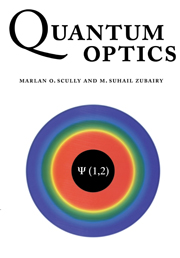Book contents
- Frontmatter
- Contents
- Dedication
- Preface
- 1 Quantum theory of radiation
- 2 Coherent and squeezed states of the radiation field
- 3 Quantum distribution theory and partially coherent radiation
- 4 Field–field and photon–photon interferometry
- 5 Atom–field interaction – semiclassical theory
- 6 Atom–field interaction – quantum theory
- 7 Lasing without inversion and other effects of atomic coherence and interference
- 8 Quantum theory of damping – density operator and wave function approach
- 9 Quantum theory of damping – Heisenberg–Langevin approach
- 10 Resonance fluorescence
- 11 Quantum theory of the laser – density operator approach
- 12 Quantum theory of the laser – Heisenberg–Langevin approach
- 13 Theory of the micromaser
- 14 Correlated emission laser: concept, theory, and analysis
- 15 Phase sensitivity in quantum optical systems: applications
- 16 Squeezing via nonlinear optical processes
- 17 Atom optics
- 18 The EPR paradox, hidden variables, and Bell's theorem
- 19 Quantum nondemolition measurements
- 20 Quantum optical tests of complementarity
- 21 Two-photon interferometry, the quantum measurement problem, and more
- Index
11 - Quantum theory of the laser – density operator approach
Published online by Cambridge University Press: 05 June 2012
- Frontmatter
- Contents
- Dedication
- Preface
- 1 Quantum theory of radiation
- 2 Coherent and squeezed states of the radiation field
- 3 Quantum distribution theory and partially coherent radiation
- 4 Field–field and photon–photon interferometry
- 5 Atom–field interaction – semiclassical theory
- 6 Atom–field interaction – quantum theory
- 7 Lasing without inversion and other effects of atomic coherence and interference
- 8 Quantum theory of damping – density operator and wave function approach
- 9 Quantum theory of damping – Heisenberg–Langevin approach
- 10 Resonance fluorescence
- 11 Quantum theory of the laser – density operator approach
- 12 Quantum theory of the laser – Heisenberg–Langevin approach
- 13 Theory of the micromaser
- 14 Correlated emission laser: concept, theory, and analysis
- 15 Phase sensitivity in quantum optical systems: applications
- 16 Squeezing via nonlinear optical processes
- 17 Atom optics
- 18 The EPR paradox, hidden variables, and Bell's theorem
- 19 Quantum nondemolition measurements
- 20 Quantum optical tests of complementarity
- 21 Two-photon interferometry, the quantum measurement problem, and more
- Index
Summary
In Chapters 5 and 7 we presented a treatment of laser physics in which the light is described as a classical Maxwell field while the lasing medium is described as a collection of atoms whose dynamic evolution is governed by the Schrödinger equation. This semi-classical theory of laser behavior is sufficient to describe a rich variety of phenomena. However, there are many questions which require a fully quantized theory of the radiation. For example, the photon statistics and linewidth of the laser can be properly understood only via the full quantum theory of a laser.
The laser linewidth is an important quantity. For example, it determines the fundamental limit of operation of an active ring laser gyroscope. The first fully quantized derivation of the laser linewidth general enough to include even the semiconductor laser linewidth problem utilized a quantum noise operator approach, and is presented in chapter 12.
The photon statistical distribution for the laser is of interest for several reasons. Historically, it was initially thought by some that the statistical photon distribution should be a Bose–Einstein distribution. A little reflection shows that this can not be, since the laser is operating far from thermodynamic equilibrium. However, a different paradigm recognizes many atoms oscillating in phase produce what is essentially a classical current, and this would generate a coherent state; the statistics of which is Possionian. But, for example, the photon statistics of a typical Helium–Neon laser is substantially different from a Possionian distribution.
- Type
- Chapter
- Information
- Quantum Optics , pp. 327 - 361Publisher: Cambridge University PressPrint publication year: 1997
- 2
- Cited by



